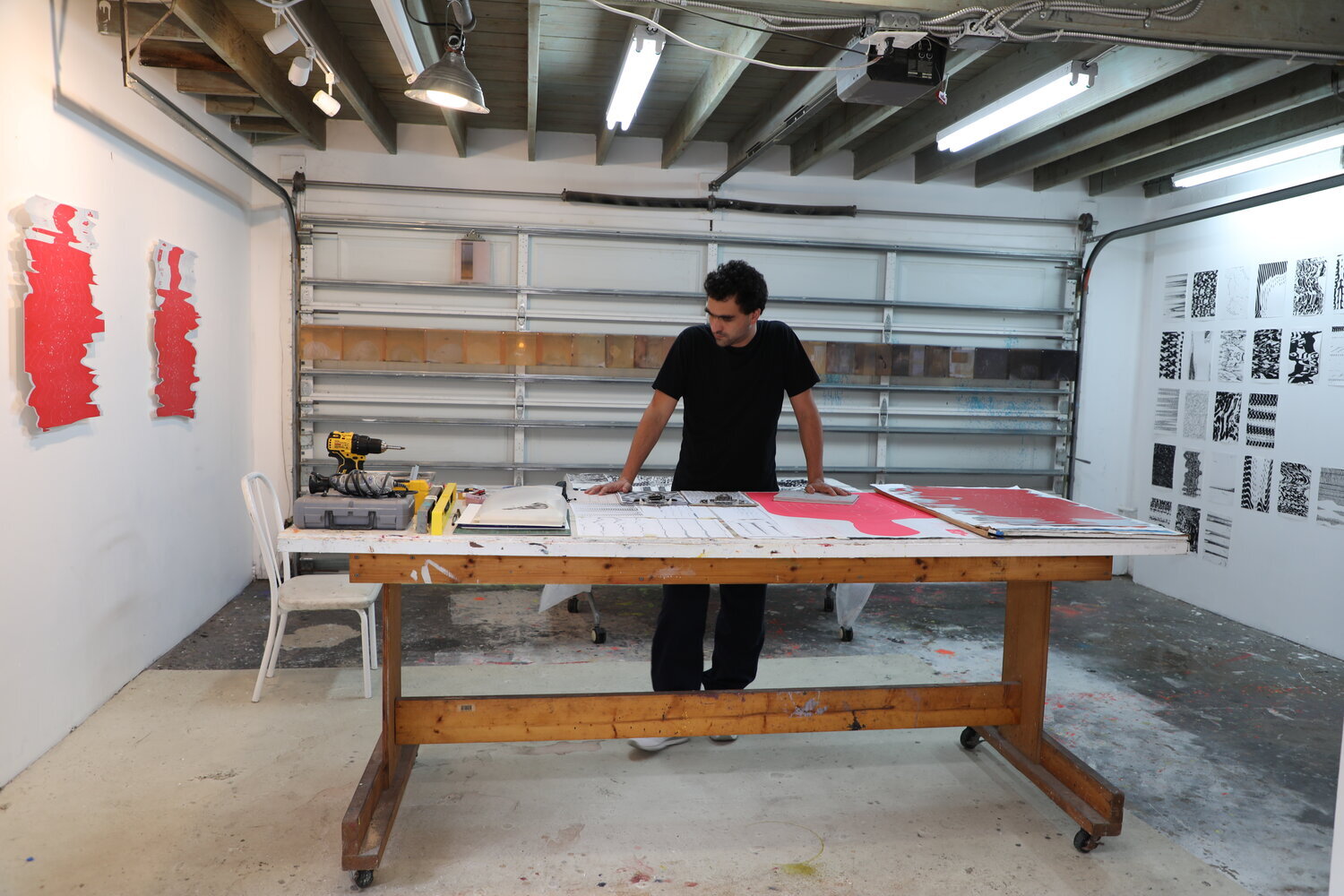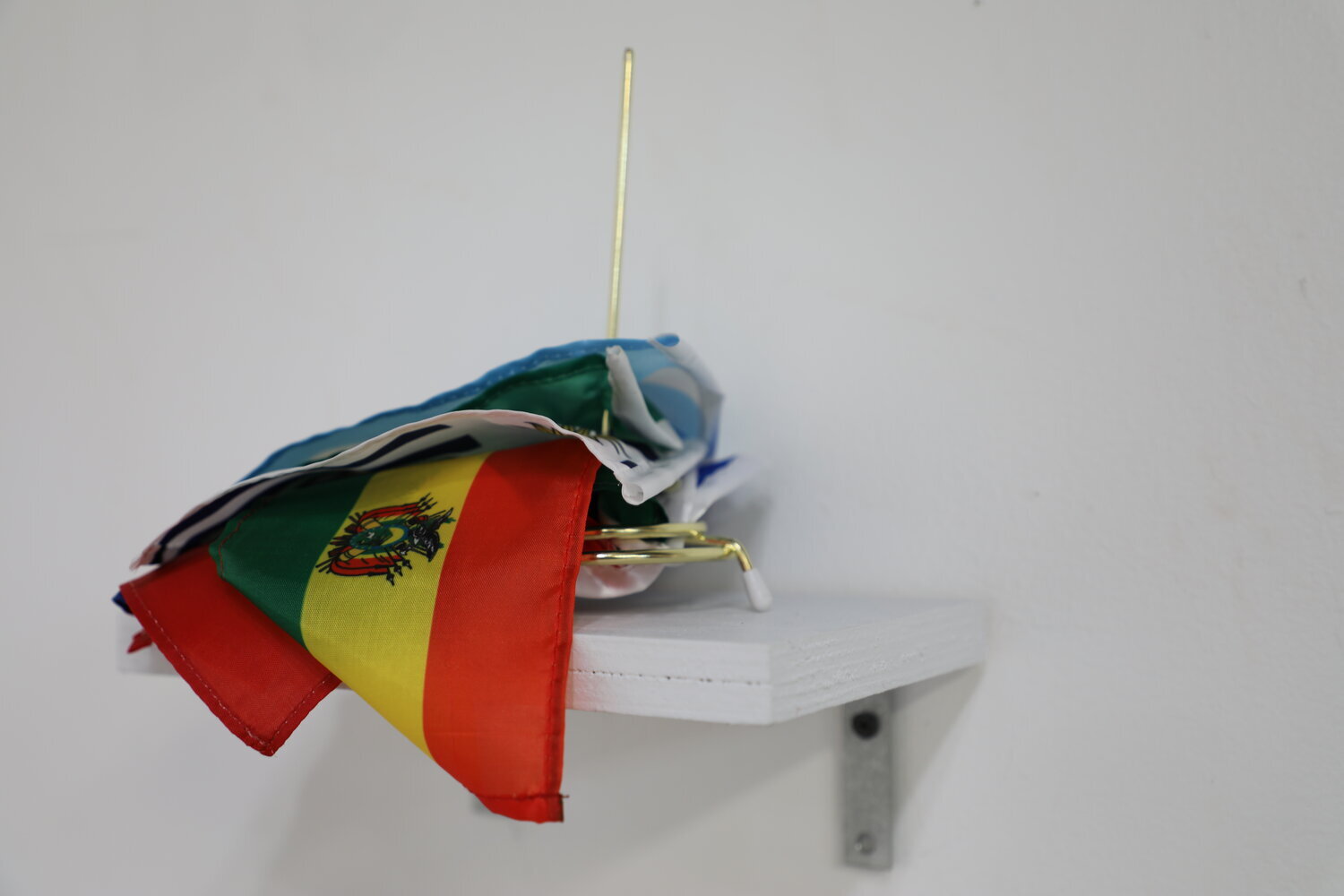May 2021
Karlo Andrei Ibarra, Maria de los Angeles Rodriguez Jimenez, Adolfo Bimer
Images courtesy of Alex Nuñez
Words by Nicole Martinez
Fountainhead often brings in artists from all over the world, but it’s rare when the artists selected for a month in residence all happen to hail from the same geographic region. May’s artists-in-residence: Adolfo Bimer, Karlo Andrei Ibarra, and Maria de los Angeles Rodriguez Jimenez - not only enriched the conversation at the Residency because of their respective experiences in Chile, Puerto Rico, and Cuba, but also allowed us to consider the boundless experimentation that the region often produces. In Latin America, where the terrain is often fertile to create artist-run spaces that operate independently of confines of the art market, artists like Adolfo and Karlo have carved out spaces of their own. The curator of this month’s residency, Christian Viveros-Faune, was interested in exploring how artist-run spaces across the Americas were fostering a new dialogue around collaboration and cross-disciplinary art production. He brought the two artists together once again, and they were joined by Maria, who currently resides in Brooklyn by way of Holguin, Cuba.
Their time in residence set the tone for future projects and also held space for what’s possible when we reach beyond geographic borders and united artists working to shape institutional programming on their own terms.
“For me, it was super important to be able to share this time with Karlo,” says Adolfo. “We were friends from before but the residency allowed me to get to know his practice from a different angle. Meeting Maria also helped me discover a new perspective and process that I hadn’t considered. The entire experience was very enriching.”
Karlo and Maria both agreed that spending time with other artists from Latin America empowered their practice. Maria said that “it's important to develop a strong relationship with artists working in latam and bring them to the states. I think conversation is important, as are international collaborations as diasporic members of the community.”
“The possibility of getting feedback from other artists who understand where you come from and what you’re making has been invaluable for me,” says Karlo.
We’re grateful we got to spend time with Adolfo, Karlo, and Maria and learn more about their work. Read their stories below.
Adolfo Bimer
Adolfo Bimer has spent a lot of time in hospitals and doctor’s offices. The endless amount of data that experience produces struck him as something that was worth exploring aesthetically. “For most of us, medical images are an abstract image,” he says, explaining that his practice has always been grounded in abstracting the body, and now draws from a source that’s slightly more precise. Where Adolfo used to riff on his own abstract interpretations of the body - using oil paints and different varnishes to reference blood or skin, for example - now Adolfo is interested in utilizing the genetic material or medical data drawn from real life samples.
Doing so allows him to reduce the human experience down to a visual representation, and there are so many elements in play: On the one hand, he’s distorting and manipulating materials the way one might treat their body, producing a result that mimics the causation of disease. On the other hand, he’s thinking about how medicine often dehumanizes people to treat them, reducing their experience down to a data point or an observation and completely muddling their identity in between. Layered underneath his practice is the idea of privacy, noting that an ‘underground bureaucracy’ allows him to access protected medical data he should have never been able to obtain.
“What I think my work reveals is that there is a structure around medical treatment that doesn’t exactly function the way it should,” Adolfo says.
The materials that make up his work range from World Health Organization data on global ailments, to vials of blood, x-rays, and microscopic slides. These objects form the basis of the work itself, which is ultimately abstracted in sculpture, drawings, or paintings depending on the concept.
Fountainhead proved highly productive for Adolfo, who has an upcoming exhibition in collaboration with Luciana Lamothe in Valparaiso and a vigorous schedule of programming with the artist-led space he co-directs, Sagrada Mercancia. “This has been the busiest month for work since the pandemic,” he says, “and it’s been very positive in both opening doors and giving visibility to the work.
Karlo Andrei Ibarra
Karlo Andrei Ibarra examines the memory embedded within a city’s architecture, thinking frequently about how acts of restoration are completed by people whose contributions are purposely erased. The colonial histories of most Caribbean cities become fodder for his works, which consider how migration - both forced and voluntary - influenced and enhanced the pace of construction. He draws attention to the anonymity of migrant workers and the cracks in the facades of our histories through material choices, working with limbs, ruptures, and paint scraps within his works.
“I think often about the colonial weight and past of those buildings, and how immigration is intertwined because those buildings were both constructed and are often restored by migrant workers,” he says. In Puerto Rico, it’s done by Dominicans; the United States, it’s done by Mexicans; in Mexico, it’s done by Guatemalans; in Costa Rica, Nicaraguans; and ultimately, these workers never get to form part of the cultural landscape they are helping to build. They’re always the other.”
Architecture motifs appear in many of his conceptual works, which also draw on geo- and socio-political contexts to imagine Puerto Rico’s - and more broadly, Latin America’s - position on the global plane. Karlo likes to work with ordinary objects - from salt shakers to neckties, maps and found posters - and transform them by hinting cheekily at their underlying political meaning, and he often criticizes hierarchies and power structures in the process. While he sometimes begins from research, he will also create from observation as a fiercely political participant in the Puerto Rican dialogue.
Like Adolfo, Karlo runs an independent art space in the Santurce neighborhood in San Juan called Km 0.2, and his time in residence was an opportunity to make work but also reflect on new directions for this project.
“It was wonderful to meet collectors here in Miami because the culture of collecting is still developing in Puerto Rico,” he says. “Being here made a huge difference for what I was able to accomplish and gave me ideas for connecting more deeply with collectors in Puerto Rico.”
Maria de los Angeles Rodriguez Jimenez
Maria de los Angeles Rodriguez Jimenez’s practice emerges from the Yoruba traditions that form an important part of her life and relationship to Cuba. Through these references of the Orishas, she’s interested in exploring her own corporeal experience. She collages found textiles, mirrors, and paint to mimic the cycles the body itself might face: From sagging skin to bleeding or scarring, Maria centers herself in the work by making it a reaction of what she’s feeling while she’s creating. Pain, periods, and aging make their way into the pieces, which Maria says are often “Significant to my own scale, and in a direct relationship to my body. If I go through something personal, it gets reflected onto the works themselves.”
Maria is especially focused on the female womb, as a source of ultimate potential. She looks to orishas like Yemaya and Oshun - the patrons of fertility and the ocean respectively - as inspiration, borrowing color influences and geometric concepts for her work. The honey and golden necklaces that might be offered to Oshun appear in bright yellow hues; Yemaya’s connection to water emerges in fluid turquoise shapes. Just as Yemaya is thought to be a giant womb, Maria often interweaves the womb and the ocean as places where anything could happen - life can be given or it can be taken violently.
When sourcing textiles for her work, Maria is attuned to how it feels and whether it can be manipulated, as she remains focused on critiquing abstraction through her process. “Creolizing and collaging these materials together puts forth a new understanding of abstract painting,” she says, “which is as something extremely charged with material and formal symbolism but resists a narrative and direct representation.” She thinks of her works in the same wya - loosely based on these historical traditions, but requiring a read of their own.
In residence, Maria spent time with her family - who continue to live in Miami - and was inspired by her surroundings as Cuban culture comes so starkly to the fore in Miami. “The relationship I have with my body also considers how being an exile and an immigrant has shaped me, and I think about borders quite a bit, as well.”









































